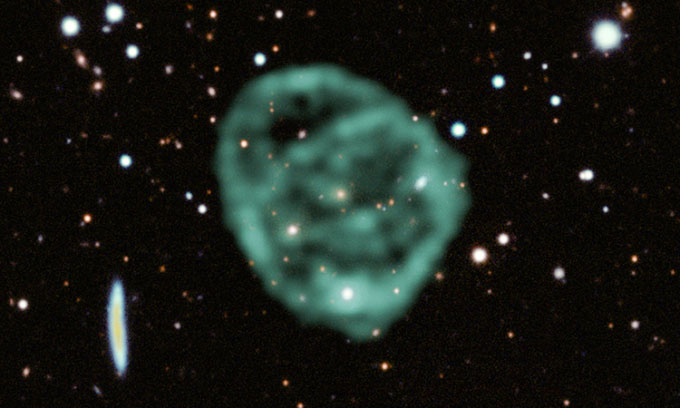A photo of a mysterious circle one million light-years wide
The MeerKAT Radio Telescope has sent back to Earth a stunning update of the mysterious radio circle known as ORC1.
Since first being discovered in 2020 by the ASKAP radio telescope, owned by Australia's national science agency CSIRO, mysterious radio circles, collectively known as ORCs, are rapidly gaining traction. the attention of astronomers.

ORC1 mysterious radio circle.
The origin of ORC is still not well understood. The top three theories suggest that they could be the remnants of a massive explosion at the center of the host galaxy, like the merger of two supermassive black holes, or powerful jets of energy spewing from the center. galaxy, or as a result of an "explosive shock" from new star production.
This updated image of one of such objects, named ORC1, was obtained by the MeerKAT radio telescope at the South African Observatory and published in Monthly Notices of the Royal Astronomical Society today. March 21 is providing researchers with more information to narrow down those theories.
The ORC is huge, about a million light-years across, 16 times larger than our galaxy. Even so, these strange radio circles are difficult to see.
To date, only 5 ORCs have been detected with radio telescopes. They cannot be observed with optical, infrared or X-ray telescopes, according to Professor Ray Norris from CSIRO, one of the study's authors.
"We know ORCs are faint rings of radio emission surrounding a galaxy with a highly active black hole at its center, but we don't know what makes them and why they are so rare." Norris shared.
ASKAP and MeerKAT are working together to find and characterize ORCs, but to understand them, astronomers will need more powerful radio telescopes, such as the SKA Observatory under construction built with support from many countries such as UK, Australia, South Africa, France, Canada, China and India.
"There is no doubt that SKA's telescopes, once built, will find many other ORCs and can tell us more about the life cycles of galaxies. Until SKA goes live, ASKAP and MeerKAT are set to revolutionize our understanding of the universe faster than ever before," added Norris.
- Mysterious light circle appears in the American sky
- The mysterious circle is the largest 5 billion light-years from the universe
- Discovery of the mysterious 'galaxy wheel' near the Milky Way Milky Way
- Mysterious black circle in the English sky
- Mysterious perpetrator creates 'fairy circle'
- Detecting mysterious light is said to be UFO in Lon Don
- The mysterious ancient stone circles in the Middle East
- Mysteriously the circle of 'devil's' land, grass cannot grow
- The mysterious circle appears in England
- Video: Mysterious giant rotating disc on the glacier
- Mysterious fire circle appears between the universe
- Mysterious circle on the field in Russia
 Van Allen's belt and evidence that the Apollo 11 mission to the Moon was myth
Van Allen's belt and evidence that the Apollo 11 mission to the Moon was myth The levels of civilization in the universe (Kardashev scale)
The levels of civilization in the universe (Kardashev scale) Today Mars, the sun and the Earth are aligned
Today Mars, the sun and the Earth are aligned The Amazon owner announced a secret plan to build a space base for thousands of people
The Amazon owner announced a secret plan to build a space base for thousands of people